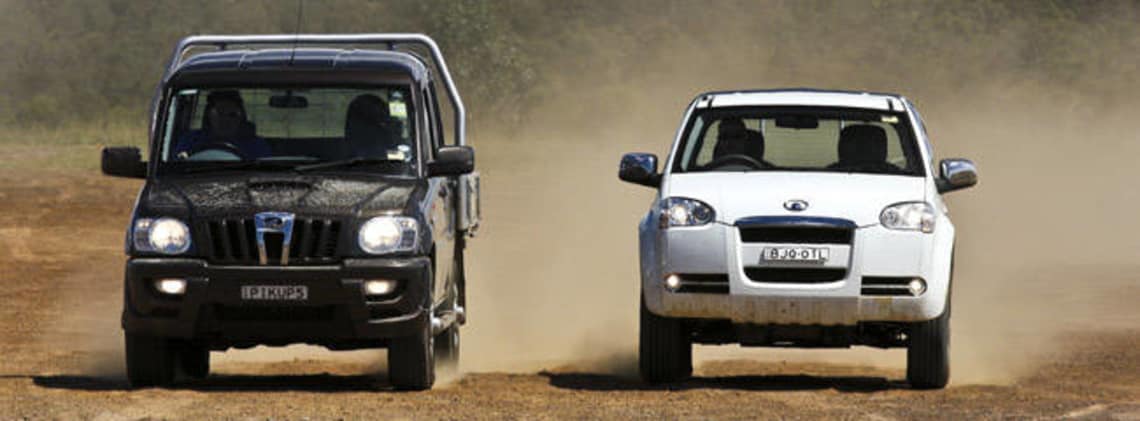
Mahindra Pickup vs. Great Wall Ute 2010
Indian brand Mahindra started the trend with a modest range of clothing a couple of years ago. Now the Chinese company Great Wall Motors has settled on our shores.
Both distributors are banking on the fact that there are people who are willing to pay the price of a used car for a brand new car with a three year warranty. The question is, will these new Asian cars be more reliable than a used car from one of the well-known brands?
Great Wall Motors V240
Aside from the bold Audi-style nose, much of the Great Wall V240 has a familiar look. On the other hand, you could be forgiven for thinking you were looking at the Holden Rodeo, right down to the doorknobs.
But believe it or not, this is a completely unique design, albeit clearly inspired by someone else. In other words, no Rodeo parts fit this baby.
The V240 is the newer of the two Great Wall models on the market and the most expensive. It is available in 2WD version for $23,990 or $4WD (the one we tested) for $26,990.
It is equipped with a 2.4-liter four-cylinder petrol engine, anti-lock brakes and dual airbags. First impressions of the Great Wall V240 are surprisingly positive. But once I thought the presentation and overall quality of the car was impressive, I found that the horn didn't work and never did in our entire stay with the car.
Leather should be cheap in China because all Great Wall models have leather seats as standard. I'm not sure traditionalists would appreciate roasting their asses on leather seats in the summer. The rear seat is a bit cramped, with limited headroom.
On the road, the V240 behaves just like a regular crew cab a few years ago. That is, it bounces a little on bumpy roads and leans into corners. This is the lower end of the ute spectrum by today's standards. At least Great Wall tried to fit the V240 alloy wheels with the right tires.
The engine is average, below average. It gets the V240 going, but it's clearly lacking in torque, and there doesn't seem to be much difference in thrust no matter what RPM it's running at. We think the off-road capabilities of the V240 are best suited to groomed dirt roads and a sparse forest trail.
Mahindra Pickup
Mahindra is slowly but surely being built in Australia. The new model has dual airbags, front seat belt pretensioners (with longer belts for beer-gutted Aussies), and anti-lock brakes as standard.
Comfort and convenience improvements include new seats, steering wheel audio controls and a tilt-adjustable steering column. The 2.5-litre turbodiesel engine, average fuel consumption of 9.9 l/100 km, vehicle pulling power (2.5 t) and payload (1000 kg to 1160 kg) are unchanged from the previous model.
But on the way a new diesel engine and an automatic transmission. We tested an all-wheel-drive crew cab chassis ($4) with an optional drop-out tray. Since there were no major mechanical upgrades, the new Mahindra rides just like the old one, although the seats are more comfortable, especially in the rear, and the bulging side mirrors make it easier to see around.
Anyone who has driven a Mahindra will understand the following comment: the strange smell in the cabin has not diminished over time. On the other hand, the Mahindra Pik-Up has the most spacious and comfortable rear seat of any crew cab in its class. Its huge. The only pity is that safety and comfort do not include a center seat with a lap belt and no headrest.
Neither the Mahindra nor the Great Wall are fast (even by the standards of their class), taking around 20 and 18 seconds respectively to reach 100 km/h with a crew on board. It is important, however, that even though it is slower to 100 km/h from a standstill, the Mahindra moves well once it picks up speed; the diesel engine's torque gives it enough traction to easily keep up with traffic.
As you might expect, with all that beefed-up suspension and off-road tires, the Mahindra handles bumps quite easily, even on perfectly smooth roads. It's risky on wet roads. Turn on stability control, we say.
In harsh conditions, Mahindra's more agricultural nature becomes an advantage. The Diesel Grunt navigates tough obstacles with ease, though it's a big beast and doesn't like tight spaces. We drive both cars through a thigh-high water barrier; only at Mahindra a little water had seeped through the door seals.
Verdict
I kept asking myself if I would invest my own money in one of them. I am a strong believer in buying big name brands for safety, reliability, resale value and dealer network support.
But the argument against you with these cars is the big price gap with the Toyota HiLux, Mitsubishi Triton and the like. So, on the one hand, what we're really talking about here is the choice between one of these new cars and a used ute brand.
I know where I'm sitting and so far this isn't one of them. If you have to choose between the two due to your budget, the Great Wall ute is more suited to the city, while the more agricultural Mahindra is more suited to the countryside.
Mahindra PikUp Double Cab 4WD
Cost: $28,999 (chassis with cab), $29,999 (with tank)
Engine: 2.5 l / cylinder 79 kW / 247 Nm turbodiesel
Transmission: 5-speed manual.
Economy:
9.9l / 100km
Safety Rating: 2 stars
Great Wall Motors V240 4WD
Cost: $26,990
Engine: 2.4 l/-cylinder 100 kW/200 Nm petrol
Transmission: 5-speed manual.
Economy: 10.7l / 100km
Safety Rating: 2 stars